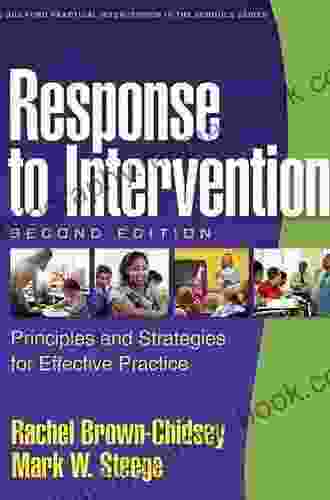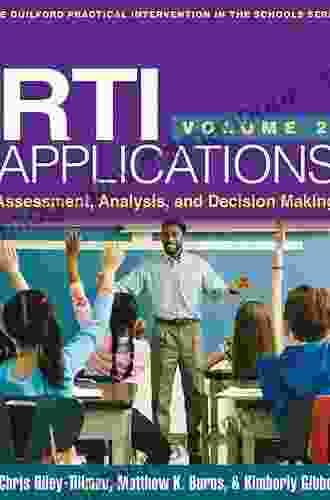Assessment Analysis and Decision Making: The Guilford Practical Intervention In-Depth Analysis

The Guilford Practical Intervention (GPI) is a widely-used assessment and decision-making tool designed to assist mental health professionals in conducting comprehensive evaluations and developing effective treatment plans for their clients. Developed by the renowned psychologist Lewis R. Goldberg, the GPI is based on a biopsychosocial model of mental health and emphasizes the importance of integrating multiple sources of information to gain a holistic understanding of the individual.
4.7 out of 5
| Language | : | English |
| File size | : | 5775 KB |
| Screen Reader | : | Supported |
| Print length | : | 164 pages |
In this article, we will delve into the theoretical foundations, components, and applications of the GPI. We will also provide practical examples of how this tool can be used to enhance the assessment and decision-making process in various clinical settings.
Theoretical Foundations
The GPI is grounded in a biopsychosocial model of mental health, which posits that psychological well-being is influenced by biological, psychological, and social factors. This model recognizes the complex interplay between biological predispositions, cognitive processes, environmental factors, and social supports in shaping an individual's mental health.
The GPI also draws upon cognitive-behavioral therapy (CBT) principles, which focus on the relationship between thoughts, feelings, and behaviors. By identifying and modifying maladaptive patterns of thinking and behavior, mental health professionals can help clients improve their psychological well-being.
Components of the GPI
The GPI consists of several key components that work together to provide a comprehensive assessment of an individual's mental health:
- Intake Interview: This structured interview collects detailed information about the individual's history, symptoms, and current functioning.
- Observation: The clinician observes the individual's behavior and interactions during the interview and other assessment activities.
- Symptom Checklist: The GPI includes a comprehensive symptom checklist that helps identify the presence, severity, and duration of psychiatric symptoms.
- Cognitive Assessment: This component evaluates the individual's cognitive abilities, including attention, memory, and problem-solving skills.
- Assessment of DSM-5 Diagnoses: The GPI assists clinicians in making accurate diagnoses based on the criteria outlined in the Diagnostic and Statistical Manual of Mental Disorders, Fifth Edition (DSM-5).
- Treatment Formulation: The clinician synthesizes the assessment findings to develop a comprehensive treatment formulation that outlines the individual's diagnosis, strengths, weaknesses, and treatment goals.
- Treatment Plan: The GPI guides clinicians in developing tailored treatment plans that address the individual's specific needs and goals.
Applications of the GPI
The GPI is a versatile tool that can be used in a wide range of clinical settings, including:
- Outpatient mental health clinics: The GPI can assist clinicians in assessing and treating individuals with a variety of mental health conditions, such as anxiety, depression, and personality disorders.
- Inpatient psychiatric hospitals: The GPI can be used to assess and manage patients with acute psychiatric symptoms and to develop discharge plans.
- Forensic settings: The GPI can inform risk assessments and treatment planning for individuals involved in the criminal justice system.
- School counseling: The GPI can help school counselors identify and support students with mental health concerns.
- Research: The GPI can be used as a research tool to investigate the effectiveness of different treatment interventions and to improve our understanding of mental disorders.
Practical Example
Consider the case of a 30-year-old male who presents to an outpatient mental health clinic with symptoms of anxiety and depression. The clinician conducts a thorough GPI assessment, which includes an intake interview, observation, symptom checklist, cognitive assessment, and assessment of DSM-5 diagnoses.
The assessment reveals that the individual meets the criteria for generalized anxiety disorder and major depressive disorder. The treatment formulation highlights the individual's history of childhood trauma, negative thinking patterns, and avoidance behaviors.
Based on the assessment findings, the clinician develops a treatment plan that includes CBT to modify maladaptive thinking patterns, mindfulness techniques to reduce anxiety, and medication to manage symptoms.
The Guilford Practical Intervention is a comprehensive and evidence-based assessment and decision-making tool that enables mental health professionals to conduct thorough evaluations and develop effective treatment plans for their clients. By integrating multiple sources of information and utilizing a biopsychosocial perspective, the GPI allows clinicians to gain a holistic understanding of the individual and tailor treatment to their specific needs.
Whether it is utilized in outpatient, inpatient, forensic, school, or research settings, the GPI has demonstrated its effectiveness in enhancing the assessment and decision-making process, ultimately leading to improved patient outcomes.
4.7 out of 5
| Language | : | English |
| File size | : | 5775 KB |
| Screen Reader | : | Supported |
| Print length | : | 164 pages |
Do you want to contribute by writing guest posts on this blog?
Please contact us and send us a resume of previous articles that you have written.
 Top Book
Top Book Novel
Novel Fiction
Fiction Nonfiction
Nonfiction Literature
Literature Paperback
Paperback Hardcover
Hardcover E-book
E-book Audiobook
Audiobook Bestseller
Bestseller Classic
Classic Mystery
Mystery Thriller
Thriller Romance
Romance Fantasy
Fantasy Science Fiction
Science Fiction Biography
Biography Memoir
Memoir Autobiography
Autobiography Poetry
Poetry Drama
Drama Historical Fiction
Historical Fiction Self-help
Self-help Young Adult
Young Adult Childrens Books
Childrens Books Graphic Novel
Graphic Novel Anthology
Anthology Series
Series Encyclopedia
Encyclopedia Reference
Reference Guidebook
Guidebook Textbook
Textbook Workbook
Workbook Journal
Journal Diary
Diary Manuscript
Manuscript Folio
Folio Pulp Fiction
Pulp Fiction Short Stories
Short Stories Fairy Tales
Fairy Tales Fables
Fables Mythology
Mythology Philosophy
Philosophy Religion
Religion Spirituality
Spirituality Essays
Essays Critique
Critique Commentary
Commentary Glossary
Glossary Bibliography
Bibliography Index
Index Table of Contents
Table of Contents Preface
Preface Introduction
Introduction Foreword
Foreword Afterword
Afterword Appendices
Appendices Annotations
Annotations Footnotes
Footnotes Epilogue
Epilogue Prologue
Prologue Dina A Amin
Dina A Amin Alexander Soifer
Alexander Soifer Jeffry A Frieden
Jeffry A Frieden Jan Philipp Sendker
Jan Philipp Sendker Bengt Jangfeldt
Bengt Jangfeldt Janna Yeshanova
Janna Yeshanova Mary Lancaster
Mary Lancaster Michael Chiarello
Michael Chiarello Michael Lewis
Michael Lewis Alfred S Posamentier
Alfred S Posamentier Robert Kirkman
Robert Kirkman Jill Lepore
Jill Lepore Jason Simmons
Jason Simmons Daniel Garrison Brinton
Daniel Garrison Brinton Angela Walters
Angela Walters Kasthuri Packiyanathan
Kasthuri Packiyanathan Vic Dimartino
Vic Dimartino Pam Brandon
Pam Brandon Palak Sehgal
Palak Sehgal Aaron Sautter
Aaron Sautter
Light bulbAdvertise smarter! Our strategic ad space ensures maximum exposure. Reserve your spot today!
 John MiltonFollow ·5.5k
John MiltonFollow ·5.5k Phil FosterFollow ·17.9k
Phil FosterFollow ·17.9k Ezekiel CoxFollow ·17.1k
Ezekiel CoxFollow ·17.1k Brody PowellFollow ·5.4k
Brody PowellFollow ·5.4k Garrett BellFollow ·14.8k
Garrett BellFollow ·14.8k Hector BlairFollow ·17.2k
Hector BlairFollow ·17.2k Aubrey BlairFollow ·3.6k
Aubrey BlairFollow ·3.6k Frank ButlerFollow ·5.6k
Frank ButlerFollow ·5.6k

 Patrick Rothfuss
Patrick RothfussHow to Make a Million Dollars: No Secrets
Making a million dollars...

 Robert Heinlein
Robert HeinleinResponse to Intervention, Second Edition: RTI in Practice
A Comprehensive Resource for Educators and...

 Timothy Ward
Timothy WardUnravel the Gripping Assassination Thriller Bursting with...
Prepare yourself for a...
4.7 out of 5
| Language | : | English |
| File size | : | 5775 KB |
| Screen Reader | : | Supported |
| Print length | : | 164 pages |


















